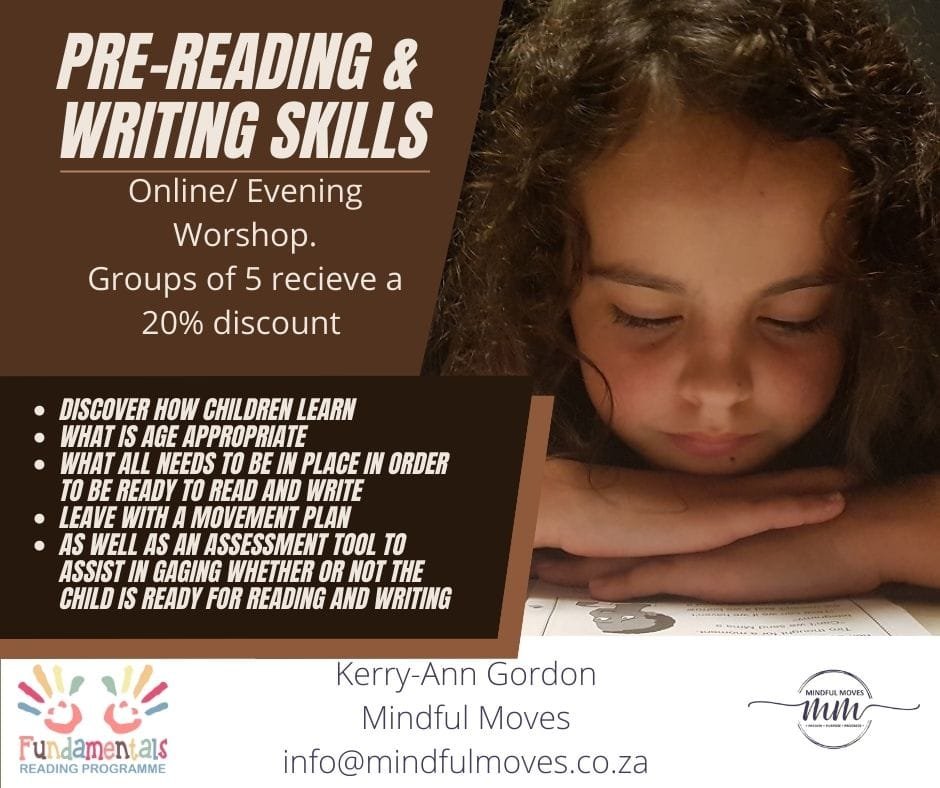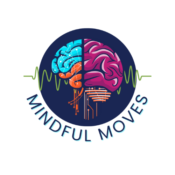The goal of early childhood should be to activate the child’s own natural desire to learn.
Maria Montessori

Tots and reading
Of late, there seems to be this pressure to get your child reading as soon as possible. I have seen many a video of a tiny tot, unable to even hold his hand up to track, supported by a parent as they are to everyone’s amazement they are able to read. It is understandable that in this competitive world, this leads to many people questioning their parenting and their ability to set their child off to a good start. Overwhelmed by the fear of being left behind, parents are in danger of pushing things that are not age appropriate and the question is, at what cost?
Instead when seeing a youngster read before he/she should, my eye goes to the whole system. I notice how they are sitting, holding their posture, I watch their eyes. I ask them questions and notice their response. Often it becomes clear that the reading has become a rote taught skill, while the system has not fully developed in order for the child to read and write with ease.
What age should my child read and write?
There are many opinions out there about the right age to teach reading and writing. However, this should not be put down to an age, but rather one should ask if the child is READY to read and write. There are many skills that must be in place in order for a child to be prepared for this cognitive skill.
Because of this, some children may be ready at an earlier age, while other children still need the movement and sensory input to develop a neural maps upon which reading and writing can develop.

What skills do children need in order to read and write?
The following is a list of areas we believe a child needs to have developed and worked through in order to be equipped to begin reading and writing. These include:
- Working on the nervous system
- Making sure infant reflexes are integrated
- Ensuring the vestibular and proprioception systems are supporting
- Making sure all the sensory organs are functioning properly
- Body Awareness
- Spatial / Orientation skills
- Working on movements of the body (homologous, homolateral, cross lateral)
- The ability to move through all THREE midlines
- Ensuring movements become automatic movement patterns that support the system
- Developed visual and auditory perceptual skills
- Making certain that children are motivated towards learning and are confident in their abilities
Noticing where the child is at.
The first thing any parent and teacher must do, is sit back and notice. Noticing is really allowing ourselves to observe our children and in so doing, appreciate where they are at. Once we know the meaning of all we have observed, we can begin working with the child. We might have the end goal in mind, that being a child who can read, write and achieve their full potential in life, but if we don’t understand where they are beginning, it becomes impossible plan and navigate a way through their current and unique obstacles.
How do children naturally learn?
Once we have noticed where our child is at, we also can appreciate that children learn naturally. This is evident in the first year of their life, where we as the adults only encourage them to participate in whatever is taking place and their reward being the feeling of love and safety as the bond between parent and child strengthens. Within this space of acceptance and fun, the child thrives and within the first year changes from being a being completely dependent on their caregivers, to a child able to walk, talk and even respond according to his/ her own feelings. As parents, our role is merely to create an environment conducive to learning. The learning is a tool, enabling the child to respond and interact with mom and dad in these very important relationships.
It’s when children feel safe, loved and supported that they can take the risks necessary to grow and develop (this we call learning). Their motivation is to become a part of the world where they can interact, explore and become.
What is our role?
Children must first feel safe. They need to be able to trust that that they can handle whatever comes their way…and if they can’t, they are aware of their support system on which they can rely to tackle the scary unknown. Parents and teachers form part of the support system. We step in as well as step back (however, never away) as the child grows through the challenges.
The Learning Flow
In our work we speak about the learning flow. This model reminds us to notice when a child is bored and work is not challenging enough as opposed to when activities are too difficult and they do not have enough life processes or available resources in which to anchor the new work.
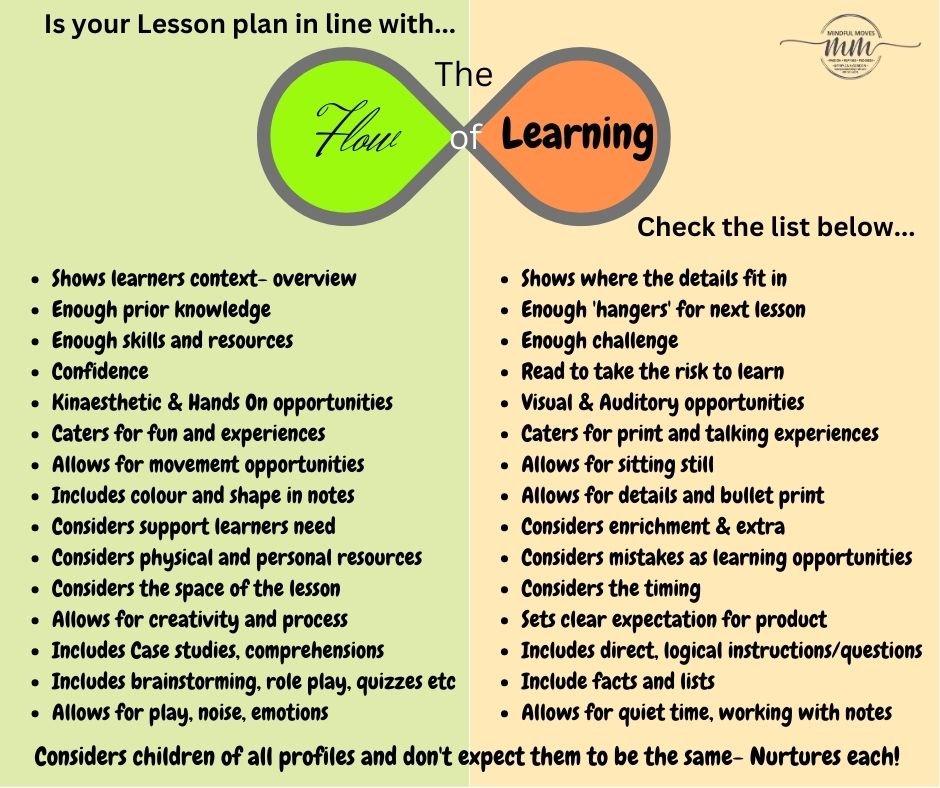
Our role with regards to the young child is to allow them to move and explore their exciting new world, incorporating as much sensory experiences as possible. We need to allow for them to move in all ways so that they can anchor and create an understanding the world and begin to develop a sense of direction within it.
Sadly, we see many children’s movement and exploration being restricted as their day includes them moving from the cot, to the carry seat/car chair, to the pram, to the roller or rocker, to the high chair and then back to the cot. This is referred to as the “container shuffle”. Older children are made to sit for hours on end in the classroom, reprimanded when they become restless or lose focus. Many children’s development is stifled by not being able to move enough or as the body needs in order to reach a level of homeostasis within.
We are overprotective
A big problem is that for so many of us, we have decided that any discomfort is a bad thing. We somehow fool ourselves into thinking that we will create the perfect life for our children and they will never want. Unfortunately, growing and development , is uncomfortable as we move out of our comfort zones and take risks, physically, emotionally and cognitively.
We step in too quickly and try to take control of all situations. We as parents believe that if we do this, our children will be protected. We’ve incorrectly, been lead to believe that if our child falls, or struggles, that we have failed them. Allowing them to learn from their mistakes is the best way for children to self-correct and develop life skills. Our ability to respond to something difficult, demonstrates to them how best to pick themselves up and try again.
Movement for reading.
Movement is a powerful tool and that is why we use it at Mindful Moves. Appropriate movement that the child intuitively seeks out, often is what the body and mind needs in order to integrate reflexes. Some children however, will avoid the movement needed when it feels to difficult for them.
Movement allows the body to move toward and pick up objects so that the sensory organs can further explore the world. This enable the development of hand-eye/ foot-eye coordination. With reflexes integrated the body can move smoothly and with coordination and in so doing strengthen, developing from the core, outwards and allowing fine muscles to then develop.
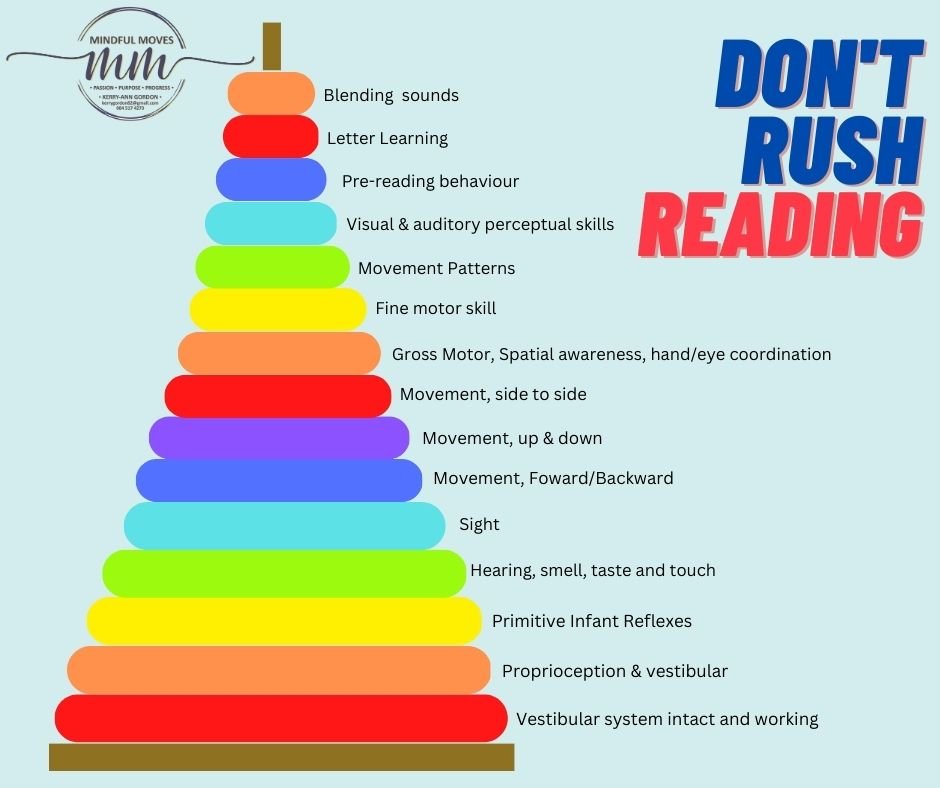
Drawing is writing and writing is active reading.
Since the young more gestalt-brained child learns through movement, it’s no wonder that writing is seen as the active form of reading. As we learn through movement, writing is a way in which we can move and create a meaningful mark.
Having said this, drawing is interpreting a message for others to read. This is evident with cave drawings, hieroglyphics, emoji’s and still within the characters of Chinese writing.
Furthermore, it is easy to see that the letters of the English alphabet are created from shapes. Drawing shapes and pictures, allows for children to experience the space on the 2-dimensional page while strengthening fine motor muscles, and readying the system from writing and reading.
Age appropriate shapes
A dot or mark, becomes a line and every soon a line becomes a shape as children explore media and paper. Letters are mostly made from lines and circles. Some lines are half circles and some lines might even be diagonals, but all letters are lines and circles placed in a certain order and space. What shapes should children be able to draw at what age”?
- Vertical Line- 2 years 10 months
- Horizontal Line – 2 and a half years -3 years
- Circle- 2 and a half years- 3 years
- Cross (horizontal and vertical line) 4 years 1 month
- Diagonal line (bottom left to top right )- 4 years 4 months
- Square- 4 and 6 months
- Diagonal line (Top left-bottom right) 4 years 7 months
- Cross using diagonal lines- 4 years and 11 months old
- Triangle- 5 years and 3 months old
- Lazy 8- six years old
- Alphabet 8’s -6years+
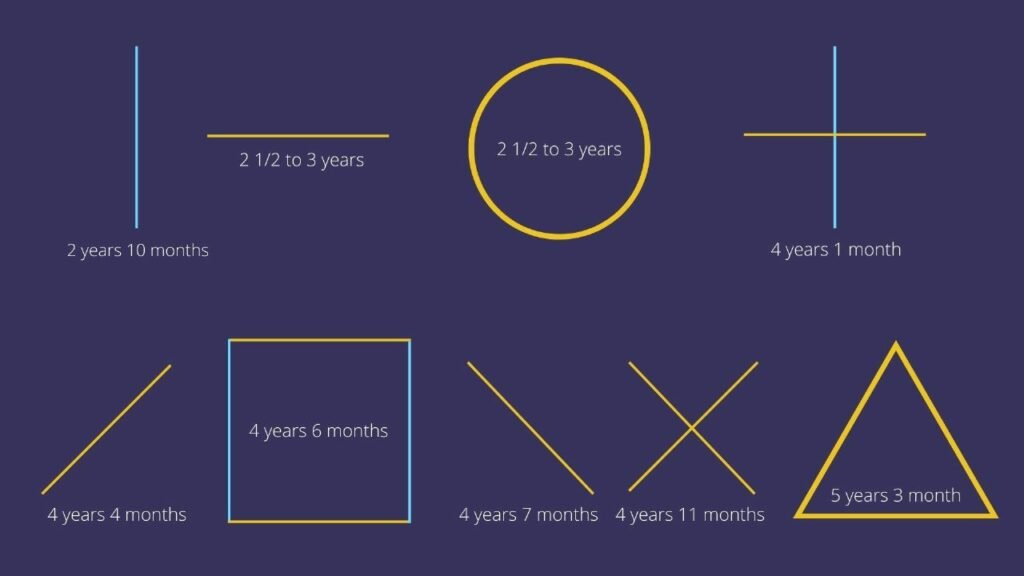
Drawing using the shapes
Using shapes, a child can begin to draw pictures to tell a story and move between the midlines of the page. Drawings can begin to represent 3-deminsional experiences which children can “read back” to you as they tell you about their picture. This allows for the other very important aspects of reading to be taught. Looking at expressions and reading between the lines, noticing feelings and attitudes. Other skills that are being developed are:
- Expression of feelings and thoughts
- The verbalising and retelling of events and situations
- Recalling events
- Predicting what would happen next
- Creative writing through storytelling
- Character creation and representation
- Spatial awareness
- Fine motor development and more…
The Benefit of Reading to your child
Dr. Carla Hannaford in her book, “Smart Moves- Why Learning is Not All in the Head” she explains how reading to a child develops the imagination. Nerve networks are established and myelinated as they create the imagery and the “movie” of the story in their head, using the images as reference. When we repeat stories, children learn the story off by heart until they can repeat this to you. They are able to even correct mom or dad if read incorrectly. At this point they can retell this story using their own words and by adding emotions and gestures. They may later role play this or act the story out while playing.
As their imagination increase, stories with fewer pictures can be read to these children and they will continue to imagine it. The beautiful truth about story-telling, is that a child can decide how scary the monster is, drawing on their own imagination. This is within the child’s control! This is far better than children being presented with inappropriate and potentially traumatising images!
Reading at bedtime allows for quality time with mom or dad away from the stimulating blue light and content on screens!
Get your child to predict what is to happen
We allow our children to engage in the story as we ask them to use their critical thinking to predict what is to happen next. We may ask them questions based on clues given in the wording or in the images or even ask them how they might solve a problem. Other ways to get them to interact with the story is to add sound effects and ask them to join in with these as well as with repeated chorus lines. We can ask them to repeat the story in their own words or explain new words they haven’t heard before. All the while they are being exposed to text and imagery which is in it’s essence emergent reading!
Enjoying reading with your child-that is what develops the love for reading!
Its the feeling and time bonding together as you join your child in this imagery world that develops the love for reading. Children who are up until the age of 7, mostly gestalt-dominant experience time and space as a feeling. The child seeks these good feelings and does more of whatever allowed them to experience these, while they do their best to avoid negative feelings such an inadequacy, humiliation, isolation and negative competition.
Children Begin to mimic writing
AS children become curious and explore text, they begin to add scribbles which represent words to their drawings. They may “read” these to you and demonstrate an understanding that writing is different to pictures. The are intrigued by these abstract symbols that hold a hidden meaning! Encourage as much of this as possible as they move from abstract lines, to the copying of letters they come across.
Skills that prove my child is ready to read and write
When we begin to naturally see children try to “read” their scribbles and write scribbles, don’t just take it that they are ready. They are interested and exploring. Turning these exciting activities into a left-brained skill that requires drilling is a sure way in turning a potential love into a loathe. Children need to remain motivated and interested. It is vital at this time, to allow them to engage in these while establishing whether or not visual and auditory skills are in place.
Be mindful of how the younger child learns. This being through;
- Play
- Movement
- Experience
- Emotion
- Using their intuition
- Drawing on curiosity
- Using shape
- Colour
- through emotional stories
- through relationship
Movement Patterns
When reflexes have been packed away, it allows movement to become fluid and automatic. Movements are mastered and now requires little cognitive thought. This in turn allows for movement patterns to develop and we can say such skills are now “supporting the child”, freeing up head space for cognitive thought so that they can build on these and learn more! This allows our perceptual skills to develop!
Eye Coordination
We cannot forget about our smaller muscles such as the eye muscles that must be able to move in all ways. Eye exercises must include the tracking and hand-eye coordination in the following directions:
- Up and down
- Side to side
- Diagonally
- Anticlockwise
- Clockwise
- in a Lazy 8
- Divergence
- Convergence
Tracking will mean that the child follows a green pointer as you move it, while hand-eye coordination involves the child tracking their own hand. We need to watch for smooth eye movements in all directions. Sadly, with the many screens and devices out there, children do not use their eyes enough for 3-dimensional/ far vision. Their eyes do very little moving around as they glance straight ahead for hours at a time, engaging in near vision activities.
Moving the eyes in these directions for no more than one minute a day is highly beneficial. Crawling, moving along the monkey bars, hanging on jungle gyms and ball gyms all assist in developing the hand-eye coordination needed for reading and writing.
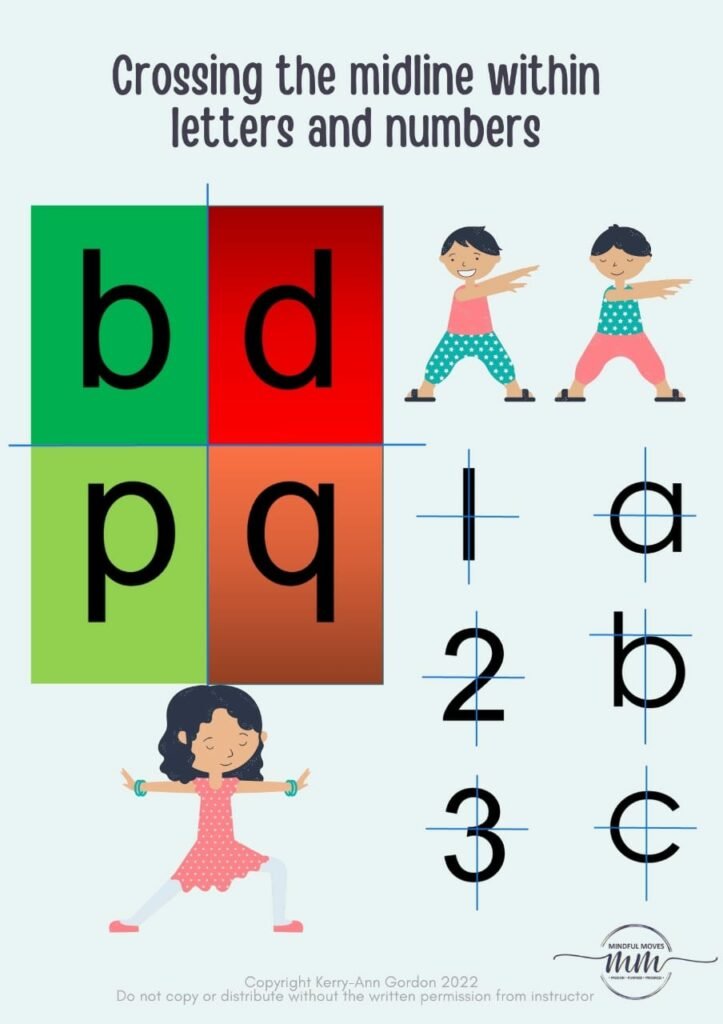
Visual Perceptual skills we need in place
As we continue to let children engage and explore while we are building their self-confidence rather than feeding their ego, we can begin to play games that develop visual and auditory perceptual skills. These are skills based on the processing and the meanings we assign to all we see and hear. This adds to our understanding of the 3-dimensional world and later our 2-dimensional world.
Visual Perceptual skills include:
- Visual Discrimination- Seeing differences and similarities- (Assists with letter and word recognition)
- Visual Analysis and Synthesis- taking apart and putting together objects (Assists with letter and word formation-spelling)
- Visual Fore and Background- filtering out irrelevant background visual stimuli and focusing on relevant visual information. This is closely linked to focus and concentration (Assists with finding ones place in the text or on the board)
- Visual Memory and Sequence- Remembering the sequence and order- (Assists with important for spelling and sentence construction.)
- Visual Constancy- identifying shapes and forms we see in different places within the environment (Assists with letter/word and number recognition )
- Visual Closure- Being able to complete an “incomplete ” or overlapping picture- (Assists later with spelling and seeing the end of the words rather than guessing having seen the beginning letters.)
When children are able to execute these skills in real life, we can move them over to board games, building blocks and finally to 2-dimensional activities.
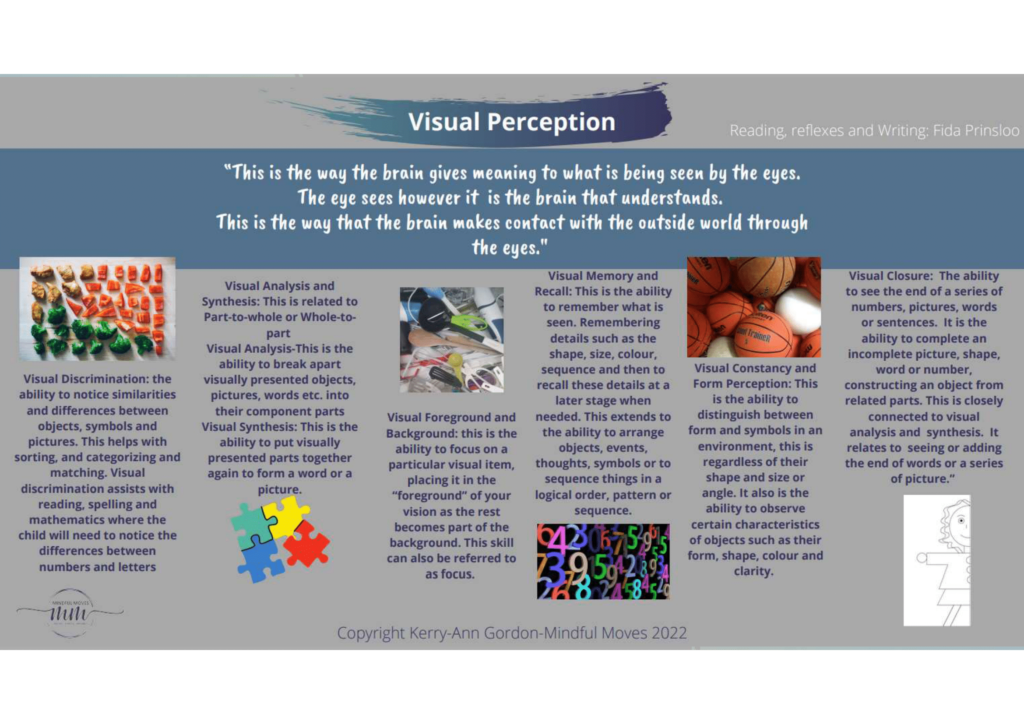
Auditory Perceptual Skills
Here we ask if the child can process what they are hearing and add meaning to this. This are vital for language as we hear the words and understand the meaning of what is being said. We interpret what we hear by listening to the details in terms of the words being said as well as listening to the pitch and tone used when saying things. Some children hear how things are said rather than what is being said while others listen to the words used rather than the way in which things are said. This is dependent on their leading ear when learning under stress.
Auditory skills include:
- Auditory Discrimination- What is being said (Assists with language development and phonics)
- Auditory Analysis and synthesis- hearing the sounds words are made up of (Spelling- Spelling out words or breaking up words into their letters by hearing the words)
- Auditory Fore and background-Bring able to drown out background noise and focus on the important things being said- (Assist in noisy classrooms)
- Auditory Memory and sequence- remembering the order in which you heard things (Assists with story telling and verbal spelling)
- Auditory Closure- To hear the end of a word- (Assists with spelling and the hearing of instructions, to predict rhyming words)
When children can do this in real life, we can move it over to story telling and games that use the fine motor muscles and finally to 2-dimensional work!

Fine Motor Skills
Instead of writing, use this time to cut, paste, play with play dough, hang on jungle gyms, paint, colour and more. As the gross motor skills develop it allows for more control and time to master the movement and coordination of the finer muscles. Children should be able to work through the age appropriate pencil grips while using tools/ stationery that is supportive of the stage of development. This include the chunkier waxies and the blunt-nosed scissors for younger children.
Let them draw using easels where their whole shoulder girdle can be used. Include finger paint and drawing with both hands. As they gain control, bigger pictures become smaller, more controlled, refined and detailed. Colouring in one direction should also transition from up and down strokes to side to side strokes as children begin to cross the midline.
In the same way when children finally are introduced to writing letters, this should be done on big pieces of paper and again you may even consider using an easel as opposed to writing in lines. This is because they need to explore the shapes of the letters as they cross over the two midlines (the vertical and horizontal midline). Only once each letters shapes are known and the child has developed control and muscle memory with regards to each letter, should they be made to try and fit them into guidelines.
Compensations and possible issues later!
With all these in place, your child is ready to learn to read and write. As you can see there is so much that must be in place before the mind/body system is ready to read and write with ease.
When we do not have all these in place, what we have actually taught our children, are compensations. We see learners needing to begin by writing capital letters as the straight lines are easier to write than the circles of the smaller letters. We end up teaching them to read using only capital letters, as they battle with word shapes (visual constancy, discrimination, analysis and synthesis). These are tactics people have used to override the fact that not is all in place to letter small letters first.
Developing these may mean that in the short term, your child can read, but the joy is short-lived as these skills cannot move over to muscle memory and automatisms and so writing and reading remains an effortful task that requires a lot of mental energy. This means less mental space for other tasks, such as listening to the teacher, holding a sentence in your mind as you write a word that is early on in that sentence.
Other issues include copying off of the board. Keeping your place as your hold a sentence and shift from far vision to near vision and back to far vision.
These compensations may slow the processing speed down and children battle to keep up with the lesson. They are labeled slow workers and constantly feel overwhelmed and as if they aren’t coping.
Another issue we look for when observing a child, is something called “cross-dominance”. This is when we map the way a child learns under stress and note that the leading hand and eye are opposite. This affects the way they work together when a child is under pressure as well as affects the child’s ability to work across the physical and visual midline of the page. A learning profile with a leading left eye also causes the eye to jump when working while stressed as this eye prefers to track from right to left instead of from left to right.
Without the knowledge to activate the whole system, these children will remain at a disadvantage when stressed and this can affect them severely during test taking and other result-driven exercises!
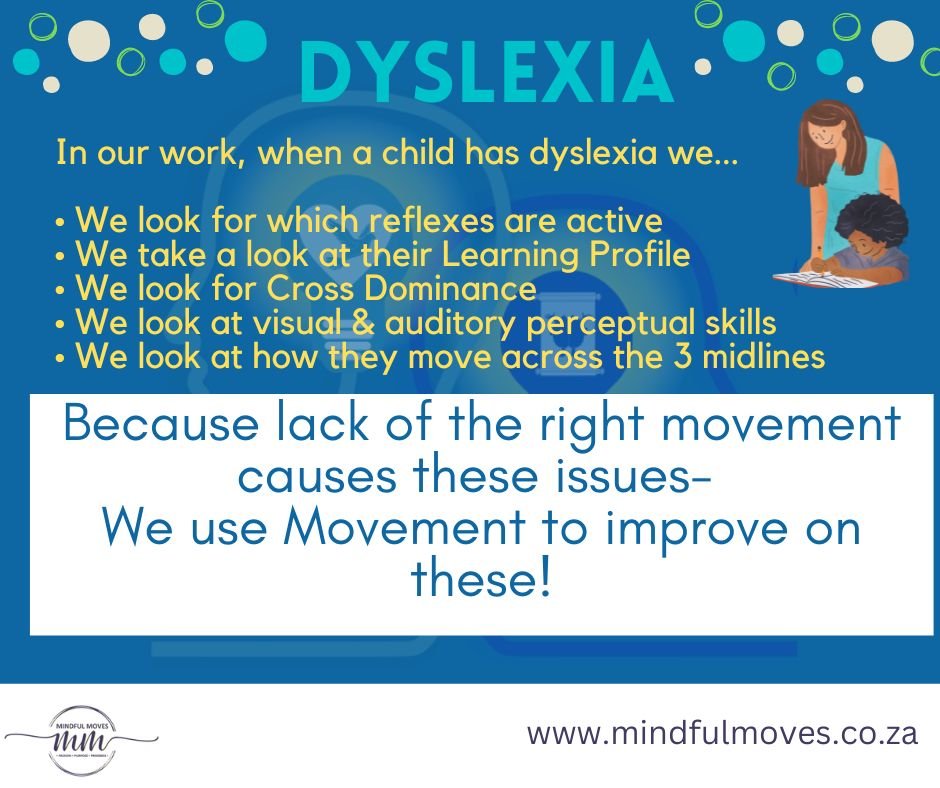
Dyslexia, Dysgraphia and Dyspraxia
Although we as teachers and parents can’t label children and quite frankly we wouldn’t want to, we can work in ways that support the children that we think might be battling with dyslexia, dysgraphia and dyspraxia. Using movements to integrate reflexes we can work with many of these that may be feeding into the issues that are red flagged as these. While this might not change a label given to a child, it will support them in as work into possible causes of the processing problem inhibiting reflexes that may be interfering with the flow of information from the sensory organs to the brain and the response from the brain back to the eyes, hands, ears, mouth etc.
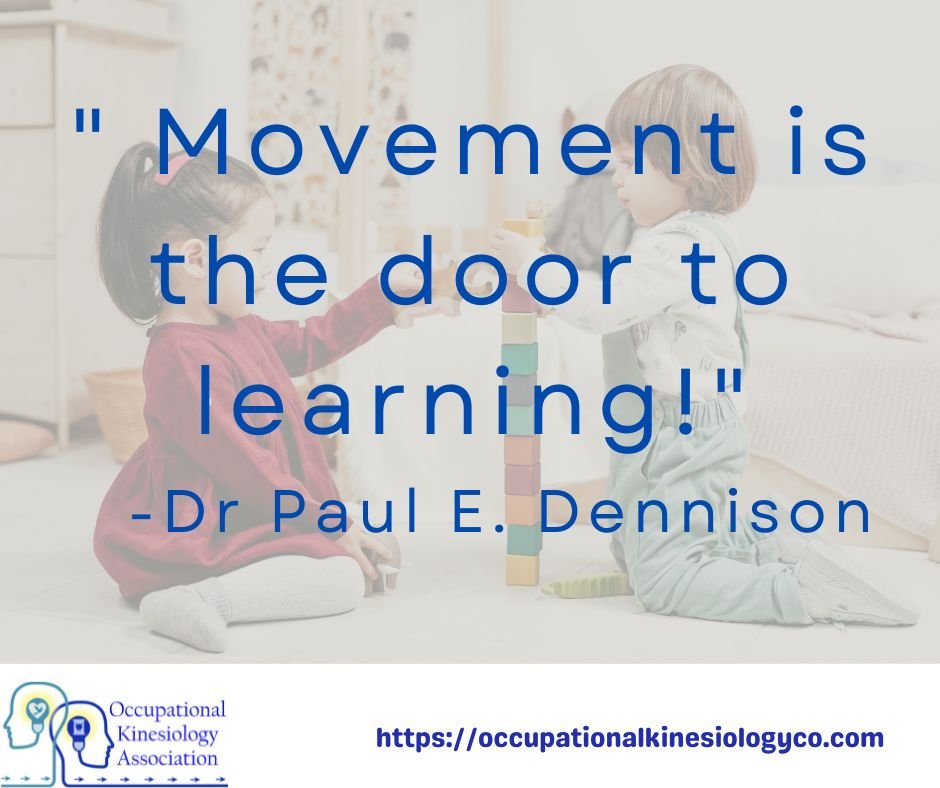
In Conclusion
Yes, we can all agree that reading and writing are very important but are they the most important taking into consideration all the skills that must be in place for easy reading and writing? I hope that by now you will agree that the seemingly mundane things mentioned are in actual fact the very important building blocks to reading and writing.
We must begin to appreciate the miracle of human life and the natural order of things. When we appreciate these stages in development of both cognitive and emotional, we witness our child’s becoming of…!
Learning is the most natural process and all we are called to do is to notice it and create the time and space for the child to engage in each stage fully! As they are rewarded with love, connection and praise they will naturally be encouraged to move toward new possibilities and learning!
Fundamentals: Pre-Reading & Writing Programme
If you would like to find out how to use a programme that encourages and brings the best out of each of these stages, consider our Fundamentals Pre-Reading & Writing Programme where you will receive a movement programme as well as a toolkit to observe if each of these skills are in place!
